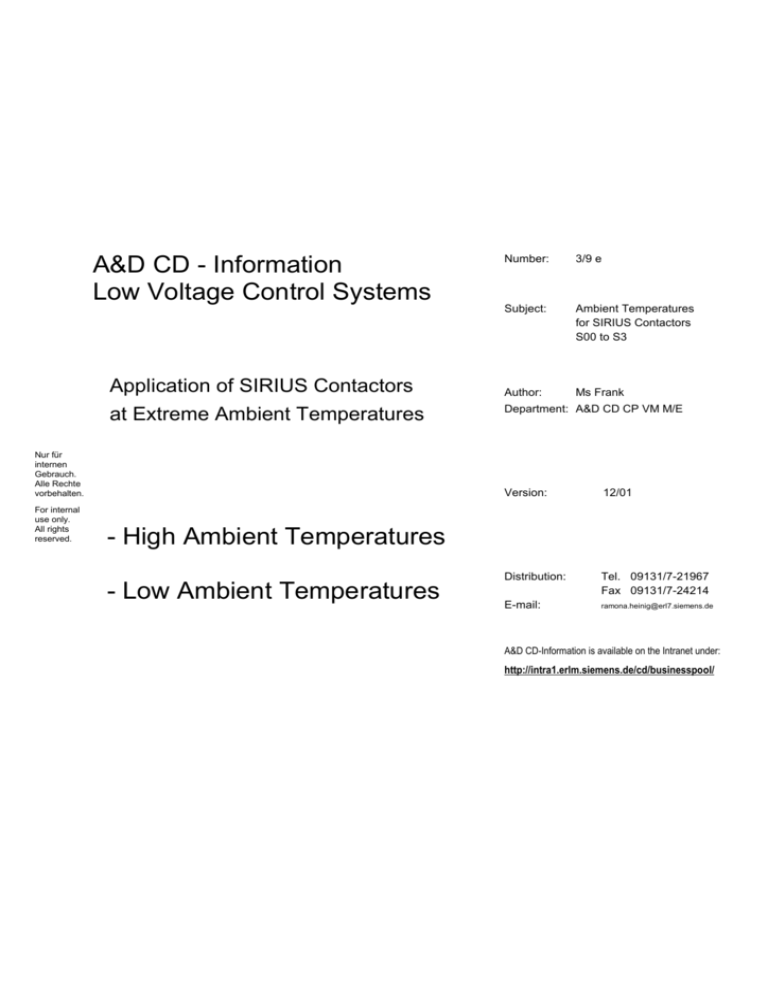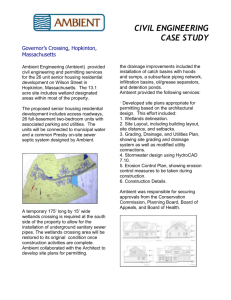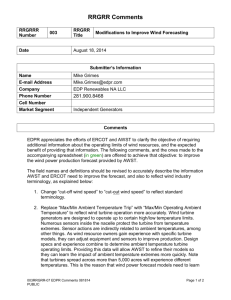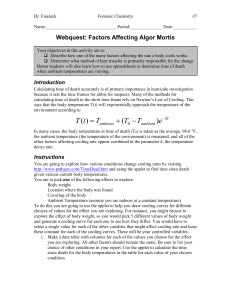
A&D CD - Information
Low Voltage Control Systems
Application of SIRIUS Contactors
at Extreme Ambient Temperatures
Nur für
internen
Gebrauch.
Alle Rechte
vorbehalten.
For internal
use only.
All rights
reserved.
Number:
3/9 e
Subject:
Ambient Temperatures
for SIRIUS Contactors
S00 to S3
Author:
Ms Frank
Department: A&D CD CP VM M/E
Version:
12/01
Distribution:
Tel. 09131/7-21967
Fax 09131/7-24214
E-mail:
ramona.heinig@erl7.siemens.de
- High Ambient Temperatures
- Low Ambient Temperatures
A&D CD-Information is available on the Intranet under:
http://intra1.erlm.siemens.de/cd/businesspool/
Information No.: 3/9 e
Subject: Ambient Temperatures for Sirius Contactors S00 to S3
Page: 2
In accordance with the international and national IEC 60 947 – 4 –1, DIN EN 60 947–4–1
(VDE 0660 Part 102) standards, low-voltage switchgear and controlgear must be designed
to be operable at ambient temperatures T a of –5 °C to +40 °C. Furthermore, most of the
Siemens switchgear and controlgear can be operated at a temperature range of T a –25 °C
to +60 °C, which exceeds the temperature range as specified by the above-mentioned
standards. This A & D information enables you to inform your customers on questions
concerning the deviations of our contactors from the ambient temperatures stated above.
Index
A
Higher Ambient Temperatures
A1
Short-time operation
A 1.1
Ambient temperatures of Ta 80 °C
A 1.2
Calculation of the average ambient temperature
A2
Continuous operation
A 2.1
Installation at ambient temperatures of > 60 °C
A 2.2
Ambient temperatures of Ta 70 °C
A 2.3
Criteria
A 2.4
Molded-plastic parts
A 2.5
Main circuits
A 2.5.1
Load rating of main circuits
A 2.5.2
Switching capacity
A 2.5.3
Switching frequency
A 2.5.4
Conductor cross-sections of the main conductors
A 2.6
Operating mechanism
A 2.7
Service life
B
Low Ambient Temperatures
Information No.: 3/9 e
A
Subject: Ambient Temperatures for Sirius Contactors S00 to S3
Page: 3
Higher Ambient Temperatures
Application of Contactors Size S00 to S3
A 1.
Short-time operation
A 1.1
Ambient temperatures of Ta 80° C
Ambient temperatures of Ta up to max. 80° C are permitted for a period of one
hour without a reduction of the permissible circuits if an average ambient
temperature of Ta 60° C is not exceeded within a 24-hour period. In
compliance with these conditions, the contactors can also be subjected to the
catalog data during continuous operation. For devices that contain electronic
components, such as contactors with an extended operating range as well as
contactors and coupling contactors with integrated overvoltage damping, the
maximum ambient temperature of 60° C, resp. 70° C, must not be exceeded
(please refer to Low-Voltage Controlgear, Switchgear and Systems Catalog
NSK, Part 3, Technical Data).
A1.2
Calculation of the average ambient temperature
Example:
The average 24-hour ambient temperature (ttotal) is to be calculated. The time
period and the temperature levels of the various ambient temperatures are
known:
80° C (T1) for 1 hour (t1)
50° C (T2) for 7 hours (t2)
35° C (T3) for 16 hours (t3)
T 1t 1T 2t 2 T 3t 3
ttotal
560Ch
= 80Ch 35024Ch
= 41.25° C
h
In this case, the average ambient temperature only amounts to approx. 41° C
and is thus not problematic, as this value may amount to 60° C, resp. 70° C,
without any reductions becoming necessary.
Information No.: 3/9 e
Subject: Ambient Temperatures for Sirius Contactors S00 to S3
A2
Continuous operation
A2.1
Installation at ambient temperatures of T a > 60°C
Page: 4
With side-by-side installation of contactors without laterally mounted auxiliary
switch blocks, a spacing of 10 mm is required for better heat dissipation. The
following data is based on the observance of such spacing.
Ambient temperature of Ta 70° C
A 2.2
With certain reductions, contactors with conventional operating mechanisms
(magnet systems) may also be continuously operated at ambient
temperatures of Ta 70° C. For devices with electronic components such as
contactors and coupling contactors with integrated overvoltage damping or
contactors in combination with additional components (electronically delayed
auxiliary switch blocks, electronic time relay blocks, overvoltage limiters,
mountable interfaces, etc.), the maximum ambient operating temperature of T a
= 60° C must not be exceeded. The 3R...–OLA0 contactors with an extended
operating range which are designed for ambient temperatures of up to 70° C
are not subject to this rule .
A 2.3
Criteria
Higher ambient temperatures result in higher stress on the
molded-plastic parts
main circuits
operating mechanisms (coil, magnet system)
This may lead to a reduction of the mechanical service life and thus to a
reduction of the devices’ operability.
Information No.: 3/9 e
A 2.4
Subject: Ambient Temperatures for Sirius Contactors S00 to S3
Page: 5
Molded-plastic parts
The parts most strongly affected are those contained in the operating
mechanism. First and foremost, the temporal period of the higher
temperatures negatively effects the mechanical strength of the molded-plastic
parts. Long ON duration periods as well as a low switching frequency are, as a
rule, more critical than a high switching frequency and short ON duration
periods.
A 2.5
Main circuits
A 2.5.1
Thermal capacity
The permissible main circuit’s thermal capacity is subject to the AC-1 or DC-1
values. Within these values, higher ambient temperatures with a respective
reduction of the rated operating current Ie/AC-1 or DC-1 and the maximum
permissible switching frequency are easy to control. The standard contactors
are designed for a maximum ambient temperature of T u = 60° C. The following
linear interdependency is valid for higher ambient temperatures of up to max.
70° C:
Ie max. = Ie /AC-1 60 C
Ta
or
Ie max. = Ie /DC-1
60 C
Ta
Ie max. =
Rated operating current of the contactor to
be calculated at higher ambient temperatures
Ie / AC-1 or Ie/ DC-1 =
Rated operating current of the contactor for
the respective utilization category and
Ta 60° C
Ta =
Actual ambient temperature
Ta > 60° C
Information No.: 3/9 e
A 2.5.2
Subject: Ambient Temperatures for Sirius Contactors S00 to S3
Page: 6
Switching capacity
The contactors’ switching capacity is not affected by higher ambient
temperatures. The Ie/ AC-3 or Ie/ DC-3/DC-5 rated operating current may,
however, not be higher than the contactors’ I e/ AC-1 or DC-1 values for the
respective ambient temperatures Ta. This must especially be observed with
larger 3RT10 contactors for AC voltage (Ie /AC-3 AC-1).
Example:
The maximum rated operating current Ie/AC-3 for a 3RT1036 contactor at an
ambient temperature of 70° C is required. Based on the catalog data, the
rated operating current Ie of this contactor is Ta 60° C: 50 A for utilization
categories AC-1 and AC-3.
Ie max. = Ie /AC-1
60 C =
50 A
Ta
60 C
70 C = 43 A
As the rated operating current Ie/AC-1 is specified to be practically equal to the
thermal rated current, the rated current of the operating mechanism must
naturally not be higher than the calculated AC-1 value (therefore 43 A in the
above example).
A 2.5.3
Switching frequency
The maximum permissible switching frequency “p” must also be reduced at
higher ambient temperatures. In principle, the same reduction factor as with
continuous operation is to be applied:
p max. p [AC-x ]
Ie / AC x 400 V 60C
I
U T
1.5
p max =
switching frequency to be calculated for higher ambient temperatures
p [AC-x] =
switching frequency valid for the applicable utilization category at
Ta 60°C (catalog data)
Ie /AC-x =
rated operating current valid for the applicable utilization category
Ta 60°C (catalog data)
I
actual operating current
Information No.: 3/9 e
Subject: Ambient Temperatures for Sirius Contactors S00 to S3
U
actual operating voltage
Ta
actual ambient temperature
Page: 7
Example:
The maximum switching frequency at Ta = 70°C and a rated operating voltage of
Ue = 500 V is to be calculated for the 3RT10 46 contactor. The rated current of the
operating mechanism amounts to 82 A and the utilization category is AC-3.
According to the Low-Voltage Controlgear, Switchgear and Systems Catalog NSK,
850 switching cycles per hour are possible and a rated operating current Ie /AC-3 of
95 A is permissible for this contactor at an ambient temperature of Ta 60 °C and
utilization category AC-3.
850
1
h
1
95 A 400V 1.5 60C
= 603
70C
h
82 A 500V
In accordance with the above mentioned conditions, the contactor may thus be
switched 603 times per hour.
A2.5.4
Conductor cross sections of the main conductors
In order to ensure sufficient heat dissipation at the main circuits, a careful calculation
of conductor cross sections must be carried out in compliance with the applicable
stipulations!
A2.6
Operating mechanism
To protect the contactor operating mechanisms (coil, magnet system) from thermal
overload at higher ambient temperatures, the operating range limits of the rated
control voltage Uc must be restricted.
The table (enclosure, last page) shows these limits. Intermediate values may be
interpoled linearly.
The IEC 60 947 and DIN EN 60 947 (VDE 0660) standards call for an operating
range of the magnet coils of 0.85 to 1.1 x Us.
Information No.: 3/9 e
Subject: Ambient Temperatures for Sirius Contactors S00 to S3
Page: 8
Despite the higher ambient temperature, the lower operating range limit, which is
critical for the function, complies with the specified value (exception: S00 DC).
A2. 7
Service life
Higher ambient temperatures result in a reduction of the contactors’ mechanical
service life. The temporal service life is most strongly influenced by the ON duration
period. The following table shows the reduced service life values:
S0 – S3
Sizes
S00
S00-S3
Ambient
Mechanical service life, Mechanical service life, Temporal
temperature Ta
switching cycles
switching cycles
service life
60°C
30 million
10 million
20 years
65°C
15 million
5 million
15 years
70°C
3 million
1 million
10 years
The values for the temporal service life are valid for a 100% ON duration period. With
a 50% ON duration period, the values may be doubled.
B
Low Ambient Temperatures
Contactors without electronic components may also be applied at ambient
temperatures of below Ta–25°C, given certain conditions are fulfilled. In such cases,
however, measures against moisture condensation must be taken (e.g. with
distribution board heating).
These contactors may be applied at minimum ambient temperatures of T a -50°C in
observance of the other catalog data. This will, however, result in a reduced
mechanical service life. High switching frequencies and ON duration periods are not
as critical to the service life as low switching frequencies and short ON duration
periods. The mechanical service life may thus be reduced by up to 50%.
Devices that contain electronic components such as contactors and coupling
contactors with integrated overvoltage damping or contactors in combination with
Information No.: 3/9 e
Subject: Ambient Temperatures for Sirius Contactors S00 to S3
Page: 9
electronic components (e.g. electronically delayed auxiliary switch blocks, time relay
blocks, overvoltage limiters, mountable interfaces...) may not be applied at
temperatures Ta below – 40°C as otherwise the integrated electrical circuits will no
longer function properly.
This also applies to the DC-operated SIRIUS contactors of size S00 (3RT1/3RH1) as
the permanent magnet integrated in the DC-operated devices may be damaged.
Note
A respective supplement will be issued for size S6 to S12 contactors as soon as the
respective technical data is available.







